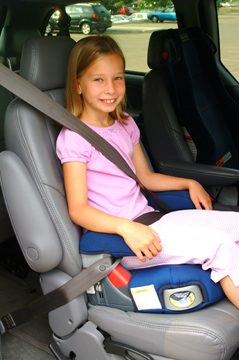Child Safety Seats
Did you know…?
- Researchers estimate that proper use of federally-approved car seats could reduce child deaths by 71 percent and injuries by 67 percent.
- National observational data shows car seat usage rate for children under four years old is above 90 percent while booster seat usage rates for children four to seven is approximately 20 percent.
- The most common mistakes made when installing a child’s car seat can also be the most deadly. #8carseatmistakes
- Three out of four car seats are not used or installed correctly.
- Not all fire and police departments have certified safety seat technicians. We have one! If you would like to have your child’s safety seat inspected or help with installation, please call for an appointment 815.467.5637 ext. 112.
Illinois Child Passenger Protection Act
Here is a brief overview:
1. All children under the age of 8 years old, must be secured in an appropriate child safety seat, i.e. rear facing, forward facing, booster seat.
2. Starting January 1, 2019, children in Illinois must remain in a rear-facing car seat until they are two years old.
3. If someone other than a parent is transporting your child, you must provide the proper child safety seat to that person.
4. If you are in violation of the Illinois Child Passenger Act:
- The first violation of this Act is a petty offense punishable by a fine of $75. A person charged with a violation shall not be convicted IF the person produces in court satisfactory evidence of possession of an approved child restraint system and proof of completion of an instructional course on the installation of a child restraint system.
- The second or subsequent violation of this Act is a petty offense punishable by a fine of $200.
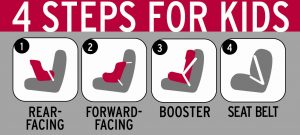
STEP 1 - Infant
For the best possible protection, keep infants in the back seat, in rear-facing child safety seats, as long as possible up to the height or weight limit of the particular seat. Rear-facing child safety seats protect the infant’s head, neck and spine in a crash. The American Academy of Pediatrics (AAP) recommends children remain in a rear-facing child safety seat until 2 years old (click here for rear-facing recommendation from the AAP).
Most convertible child safety seats can be used rear-facing from 5-30 or 40 pounds. If a child safety seat accommodates children rear-facing to higher weights, the child should remain rear-facing until reaching the maximum weight for the child safety seat, as long as the top of the child’s head is at least an inch below the top of the safety seat back.
Infant-only child safety seats are designed for rear-facing use only
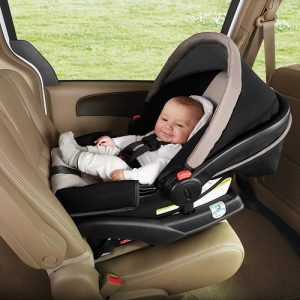
Convertible child safety seats are designed for older babies and can be used rear–facing to higher weight limits and then forward-facing
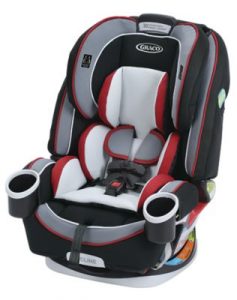
STEP 3 - Booster
In Illinois, by law children who have outgrown their child safety seat must be properly restrained in a booster seat until they are at least 8 years old. The American Academy of Pediatrics recommends booster seat use until the adult belt fits properly – which could be as old as 12 years for some children.
- Safety belts are designed for small adults who are at least 80 pounds and 4 feet 9 inches tall. Until age eight, most children have not developed strong hipbones, and their legs and body are too short for the adult safety belt to fit correctly.
- A belt that rides up on the tummy could cause serious internal injuries to vital organs. Many young children do not sit still or straight enough to keep lap belts low across their thighs or the strong hip bones.
- Booster seats are comfortable for children because they allow their legs to bend normally and help them sit up straighter so the adult safety belt fits. Booster seats also allow kids to see out the window better
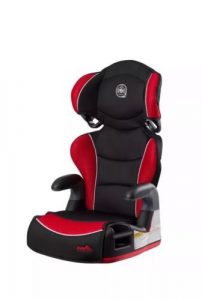
High back belt–positioning booster seats also boost your child up so the vehicle safety belt fits better. It provides head and neck support for your child if your vehicle seat back does not have a head restraint. It must be used with the vehicle’s combination lap and shoulder safety belt, never with a lap-only safety belt.
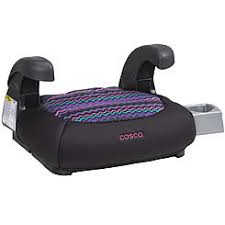
Backless belt–positioning booster seats boost your child up so the vehicle safety belt fits better. This booster seat is used with the vehicle’s combination lap and shoulder safety belt, never with a lap-only safety belt. It should only be used in vehicles with head restraints that are tall enough to protect the child’s head and neck. The head restraint must be at least as tall as the top of the child’s ears
STEP 2 - Toddler
The American Academy of Pediatrics (AAP) recommends children remain in a rear-facing child safety seat until 2 years old. When the child has reached the upper height and weight limits of the rear-facing convertible seat, he or she may face forward in a convertible seat or a combination child safety seat/booster. Some forward-facing child safety seats are built into the vehicle seat.
A child should ride in a child safety seat with a harness until they reach the upper weight limit, which is typically about 40 to 65 pounds.
For children 40 pounds or more who are too young or too active to sit still in a booster seat, or if a vehicle has only lap belts, use child restraints labeled for use over 40 pounds with a harness.
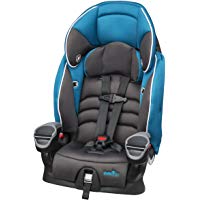
- The harness straps must be snug and lay on child’s shoulders, not arms. If the harness is even slightly loose, the baby can be thrown out of the seat in a crash.
- The harness straps must be placed at or above the child’s shoulders in the reinforced slots for the forward-facing positions. Use the very top slots if you are not sure which slots are reinforced. Review the instruction manual for more information.
- The child safety seat should be in the upright position for the best protection. Review the instruction manual for further information.
- The plastic harness retainer clip must be placed even with the child’s armpits to hold the harness straps on the shoulders. Do not use a child safety seat without a harness retainer clip unless instructed to do so by the manufacturer
- Do not place any padding, noodles or other objects behind or under the child safety seat.
- Thick padding must NOT be put under or behind the child.
- Be sure to place the safety belt or LATCH strap through the correct belt path. The forward-facing belt path is usually found near the back of the child safety seat. Review the instruction manual for further information.
STEP 4 - Safety Belts
SAFETY BELTS
When is a Child Ready for an Adult Safety Belt?
Safety belts are designed for adults – not small children. The American Academy of Pediatrics recommends that children ride in a belt positioning booster seat until the safety belt fits as it would an adult – which could be as long as 12 years old for some children.
The lap portion of the safety belt must fit low and tight across the upper thighs. The shoulder portion of the safety belt should rest over the center of the shoulder and across the chest.
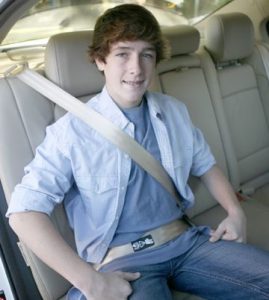
To be able to fit in a safety belt, a child must pass this 5-step test:
- Be tall enough to sit without slouching,
- Keep his/her back against the vehicle seat back,
- Keep his/her knees completely bent over the edge of the seat
- Keep his/her feet flat on the floor, and
- Be able to stay comfortably seated this way for the entire trip.
Never put the shoulder portion of the safety belt under the child’s arm or behind the child’s back. This can cause severe internal injuries in a crash. If the safety belt does not fit properly, the child should use a belt-positioning booster seat.

